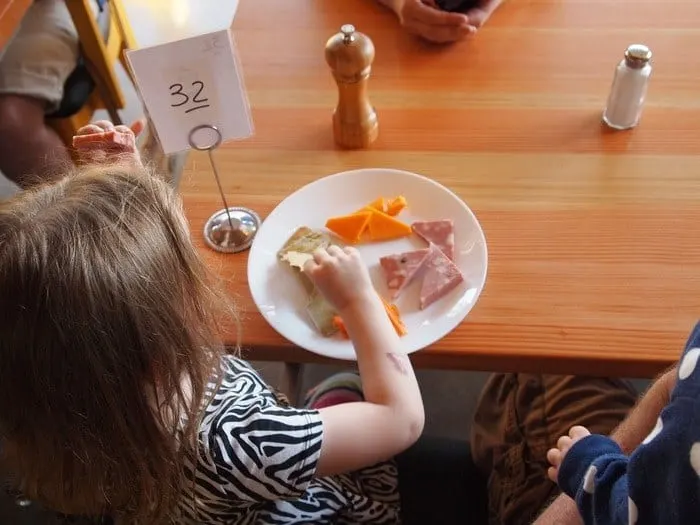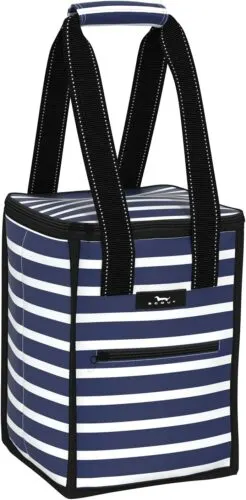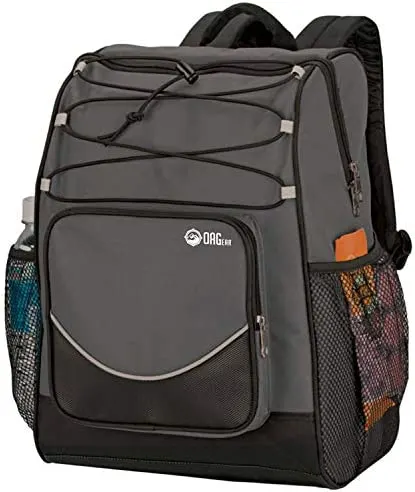One of the most fun parts of being on vacation is eating good food. For us that means finding yummy local foods we don’t eat at home. For some parents it means having fancier meals than you do day-to-day.
But for a lot of kids vacation means getting to eat chicken fingers and ice cream every day for a week. Or not eating anything because all the food they’re given is new and suspicious.

We face unique challenges feeding our kids on vacation that we don’t face at home. One challenge is making sure they don’t get too much sugar and that they eat fruit or a vegetable now and then.
We also have to deal with kids being too excited or tired to eat enough when mealtime rolls around or that we time things badly and wind up with hungry, grouchy, crying kids (and maybe adults, too, if we’re honest).
Here are four of the top challenges of making sure kids eat well (or just eat at all) when you travel —and of coures some practical tactics for getting around them.
You might also want to read:
• The Best Tips for Helping Car-Sick Kids
• 4 Savvy Safety Tips for Healthy Summer Travel
• 33 Savvy Professional Tips for Safe & Healthy Family Travel
7 No-Fuss Solutions To Help Kids Eat Healthily on Vacation
Challenge 1: Not missing meals in transit
Flight and train schedules and traffic jams can easily conflict with meal times. If we’re driving in a new place we don’t know where we’ll be and what will be available when hunger rolls around.
The Solution:
Once you’ve scheduled your flight, train ride, or driving route, make your best guess as to where you’ll be around mealtimes and make a plan for how you’ll handle it. Will you be fed on the plane? Will you plan a driving break in a certain town with plenty of restaurants? Will you bring a meal from home to eat in the terminal, train station or at a rest stop?
Regardless of your dining plans, bring more snacks than you think you need. And include a few that can hold you and your kids well in case you run up against delays, weather, poorly timed naps or other unexpected problems.
Some heartier foods to pack:
- packets of nut butter
- bananas
- Crustables
- babybels or Laughing Cow cheese
- whole grain crackers
- granola bars with protein
- shelf stable milk, dried salami kits
- nuts or dried chick peas
- shelf-stable lunch kits
- Olives in sealed travel packs
- Hummus cups can be fine outside of a fridge for a good 12 hours.
Challenge 2: Staying on budget
Eating three meals a day in restaurants is not necessarily relaxing with very young kids. And if you have teens withlarge appetites eating cheaply on vacation is never easy.

The Solution:
Consider a vacation rental or a hotel room with a full kitchen. You can keep your kids favorite breakfast items on hand, keep the fridge full of water bottles or juice boxes, and make lunch to take along if you like.
If this isn’t practical for you, try to at least book a hotel room with a refrigerator and microwave. You can keep, yogurt, milk and cereal on hand and fix hot dishes like single-serving oatmeal.


Regardless of where you stay, consider packing an insulated bag that will keep food and drinks cold. There are coolers you can wear as a shoulder bags or backpack. This gives you the option of packing lunch or picking up prepared items from a grocery store or farmers’ market while you’re out. Rotisserie chickens are easy to find and pair with chips, fruit or to-go salads for a picnic lunch or carry-out dinner.
Find a bag with a extra pockets for things like your wallet, keys and phone so everything is one place.
Cynthia says: If we were staing at a hotel and relying on restaurants, we always ate our our main meal at lunch. Food is often much less expensive than at dinner and the kids weren’t yet tired and cranky. At the end of the afternoon we’d duck into a local market for whatever light foods caught our eye and we would “picnic” in our hotel room.
Challenge 3: Confronting travel tummy
New flavors and types of food can have unexpected affects on our digestive systems. And even close to home, who hasn’t overdone it, say with with too much ice cream (or piña coladas) on vacation now and again?
The Solution:
I give my family probiotics leading up to any overseas trip and sometimes I take them with me. The idea is that boosting the good bacteria in your system makes you less susceptible to any bad stuff you might come across.
In developing countries, stick to bottled drinks and hot, cooked food. Avoid raw vegetables and only eat fruit you peel and cut up yourself. We never have soda at home but in places where the water isn’t always good, I rather my kid have a bottle of Coca Cola (which is available everywhere) than a travel bug.

Even in North America and Europe, pack medications that will mitigate nausea, diarrhea and dehydration (enough to last you until you can find a pharmacy). Peppermint and ginger teas are handy to have around for mildly upset stomachs.
Additionally, you or your child could have food allergies that you’re unaware of, that emerge when you meet new ingredients for the first time on vacation. Always carry Benadryl. Watch for rashes that will not go away, or grow worse within a few hours.
When in doubt call a doctor or dermatologist (your own if possible). They can tell you how to manage the situation and if you need to see a doctor locally.
Challenge 4: Feeding the kid who won’t eat anything
If one of your kids is very picky about what they eat then I actually recommend against revolving vacation meals around his limited preferences. He or she might not eat much no matter what you do. And the rest of the family won’t enjoy their vacation as much as they could.
The Solutions:
Decide not to worry about balanced meals
Do your best to make sure each kid eats at least one good meal a day; breakfast is often the easiest meal for finding healthy, filling foods kids like. But don’t make an issue of it. It’s less stressful for you to give up worrying. And you’ll make up any temporary nutrition gaps when you’re back home.
If one of the kids just doesn’t eat much or finds one thing they want to eat it every day, let them. When we were in Edinburgh, Tween Traveler ate fish ‘n’ chips once a day. In Senegal (where I was really worried there’d be nothing she’d like) she ate roast chicken and rice for lunch every single day.

Keep a stash of healthy snacks you know your kids can fall back on if they don’t manage a good meal all day. These might include cereal bars, yogurt, local fruit, and ramen or instant Mac & Cheese if you can do some basic food prep.
Give kids a say in what you eat
Let each kid, including the picky one, choose what the family eats for dinner on one night of the trip; this could mean choosing the type of restaurant you go to, the take-out you get or the meal you cook.

Take the risk out of experimenting
Cynthia says: On our travels in Europe we had a system of ordering two “safe” dishes – ones we knew the kids liked back home – and two unfamiliar “adult” dishes. We shared everything family-style.
Often, after the kids tried a non-threatening bite or two of our dishes they’d keep on spooning it in. Other times they’d look disinterested, then surprise us by greeting that same dish as an old friend on some menu a few days later.
Even McDonalds can be an adventure
Even kids who aren’t picky will crave a bit of “back home” in a very unfamiliar environment.
No matter where you are and how ridiculous it might seem, always have a pizza night. It’s an easy, budget friendly dinner. You can observe the local twists and compare pizza from different places. And even if it’s not the best pizza you’ve ever had it’s one meal you know everyone will eat.
Cynthia says: We turned familiar fast food into an opportunity to open their eyes. We’d always have them look for what was different in overseas fast food outlets. In England, Pizza Hut offers tuna, shrimp and sweet corn among its toppings. In Spain, Burger King sells beer as well as soft drinks.
Pin it for later!

Cynthia Harriman is Director of Food and Nutrition Strategies at Oldways, a Boston-based nonprofit that promotes healthy eating through traditional ways of preparing foods, cooking and eating. She’s also the author of Take Your Kids to Europe, How to Travel Safely and Sanely with your Children.

